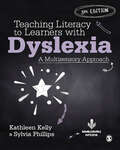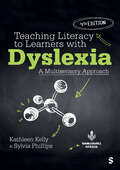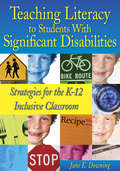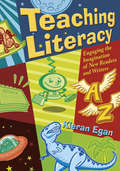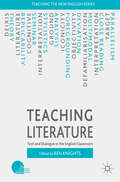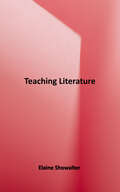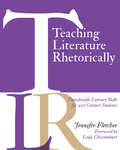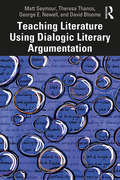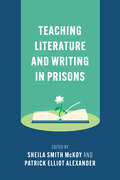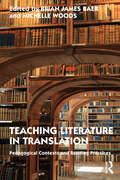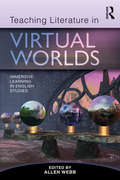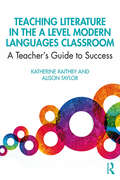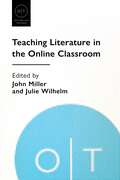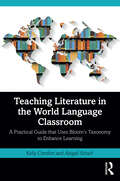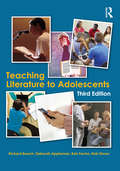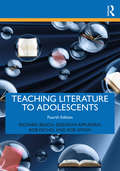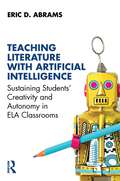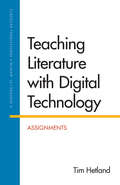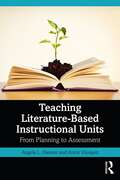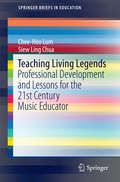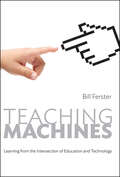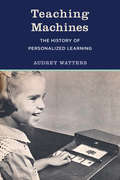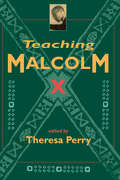- Table View
- List View
Teaching Literacy to Learners with Dyslexia: A Multisensory Approach
by Kathleen Kelly Sylvia PhillipsThis bestselling book for teaching literacy to children and young people aged 4–16 years with dyslexia and other specific literacy difficulties has been fully updated for its third edition. Providing a structured multi-sensory programme, ‘Conquering Literacy’, that includes placement tests, well-established strategies and examples of lesson planning, teaching activities, and reading, spelling and literacy concept cards, this book is an essential practical resource for teachers. This new edition includes: an additional section for learners who need an individualised, structured programme at an advanced stage (Stage II); a section on planning shorter, targeted interventions for learners with a particular difficulty e.g. spelling, revising; three new chapters on teaching reading, spelling and writing within mainstream classrooms using strategies which are successful with learners with dyslexia downloadable teaching resources available from the companion website.
Teaching Literacy to Learners with Dyslexia: A Multisensory Approach
by Kathleen Kelly Sylvia PhillipsThis bestselling book for teaching literacy to children and young people aged 4-16 years with dyslexia and other specific literacy difficulties has been fully updated for its fourth edition. Providing a structured multisensory programme, ‘Conquering Literacy’, that includes placement tests, well-established strategies and examples of lesson planning, teaching activities, and reading, spelling and literacy concept cards, this book is an essential practical resource for teachers. This new edition includes: • 51 new activities (online) to support the delivery of the Accelerated Programme. • A new chapter on co-occurring difficulties and the implications for teaching literacy using Conquering Literacy. • Additional examples and case studies. • New resources within the book itself, to support the teacher in delivering the lessons. • A variety of structured reading materials to develop reading comprehension for students working at Stage 2 of the programme.
Teaching Literacy to Learners with Dyslexia: A Multisensory Approach
by Kathleen Kelly Sylvia PhillipsThis bestselling book for teaching literacy to children and young people aged 4-16 years with dyslexia and other specific literacy difficulties has been fully updated for its fourth edition. Providing a structured multisensory programme, ‘Conquering Literacy’, that includes placement tests, well-established strategies and examples of lesson planning, teaching activities, and reading, spelling and literacy concept cards, this book is an essential practical resource for teachers. This new edition includes: • 51 new activities (online) to support the delivery of the Accelerated Programme. • A new chapter on co-occurring difficulties and the implications for teaching literacy using Conquering Literacy. • Additional examples and case studies. • New resources within the book itself, to support the teacher in delivering the lessons. • A variety of structured reading materials to develop reading comprehension for students working at Stage 2 of the programme.
Teaching Literacy to Students With Significant Disabilities: Strategies for the K-12 Inclusive Classroom
by June E. DowningBreak down the barriers to successful literacy instruction and empower students with special needs with these insightful tips, tools, and examples.
Teaching Literacy: Engaging the Imagination of New Readers and Writers
by Kieran EganThis unique approach to teaching core literacy skills offers step-by-step planning frameworks and an appendix of activity ideas to show teachers how to engage students in the process.
Teaching Literature
by Ben KnightsThis book comprises reflections by experienced scholar teachers on the principles and practice of higher education English teaching. In approaching the subject from different angles it aims to spark insights and to foster imaginative teaching. In the era of audit, and the Teaching Excellence Framework it invites teachers to return to the sources of their own teaching knowledge. The shift from a student-centred to a research-centred paradigm has particular implications for a discipline which prides itself on its teaching, and has always had teaching and dialogue at its heart. One which also talks across the tertiary / secondary border to the cognate (though different) subject called 'English' in school. The argument which informs this book, and which is developed in the individual chapters, is that the future of the subject relies not alone upon fostering communities of 'research excellence', but on re-awakening and reviving its pedagogic traditions.
Teaching Literature
by Elaine ShowalterThis book is an inspirational guidebook for all English and American literature teachers in higher education. - Written by leading academic, prolific author, and cultural journalist, Elaine Showalter - Original and provocative reflections on teaching literature in higher education - Encourages teachers to make their classroom practice intellectually exciting - Wide-ranging - covers the practical, theoretical, and methodological aspects of teaching literature - Highly practical - employs real examples from real classes and careers throughout - Draws on 40 years of international teaching experience
Teaching Literature Rhetorically: Transferable Literacy Skills for 21st Century Students
by Jennifer FletcherEnglish language arts teachers often find themselves defending their discipline and the practical values it has. When will I read this again? is an all too common question heard in classrooms. Author Jennifer Fletcher faced the same questions and more. In Teaching Literature Rhetorically: Transferable Literacy Skills for 21st Century Students she shows you how to help your students develop transferable literacy skills that allow them to succeed not just in their English language arts classes, but in their future lives and careers. The book is built around eight high-utility literacy skills and practices that will help students communicate effectively and with confidence as they navigate important transitions in their lives: Integrating skills and knowledge from texts Reading closely and critically Assessing rhetorical situations Negotiating different perspectives Developing and supporting a line of reasoning Analyzing genres Communicating with self and others in mind Reading and writing with passion Teaching Literature Rhetorically offers readers writing prompts, readings, discussion questions, graphic organizers, as well as examples of student work and activities for helping students to understand key rhetorical concepts. As Fletcher writes in her introduction rhetorical thinking promotes the transfer of learning — the single most important goal we can have as teachers if we hope to have a positive impact on our students&’ lives. This book will help teachers everywhere do just that.
Teaching Literature Using Dialogic Literary Argumentation
by George E. Newell David Bloome Matt Seymour Theresa ThanosIntroducing a new framework for teaching and learning literature in secondary schools, this book presents Dialogic Literary Argumentation as an inquiry-based approach to engage students in communicating and exploring ideas about literature. As a process of discovery, Dialogic Literary Argumentation facilitates conversation—"arguing-to-learn"—as a method to support students’ diverse perspectives and engagement with one another in order to develop individual and collective understandings of literature and their place in the world. Covering both the theoretical foundation and application of this method, this book demonstrates how to apply Dialogic Literary Argumentation to teach literature in a way that foregrounds dialogue, learning through inquiry, diverse views, listening to others, and engagement with our communities. Ideal for preservice teachers in literacy methods courses and practicing teachers, it features real-world cases, discussions of the principles presented, resource lists, and conversation starters for professional learning communities, professional development, and teacher education.
Teaching Literature and Writing in Prisons
As the work of Malcolm X, Angela Y. Davis, and others has made clear, education in prison has enabled people to rethink systems of oppression. Courses in reading and writing help incarcerated students feel a sense of community, examine the past and present, and imagine a better future. Yet incarcerated students often lack the resources, materials, information, and opportunity to pursue their coursework, and training is not always available for those who teach incarcerated students. This volume will aid both new and experienced instructors by providing strategies for developing courses, for creating supportive learning environments, and for presenting and publishing incarcerated students' scholarly and creative work. It also suggests approaches to self-care designed to help instructors sustain their work. Essays incorporate the perspectives of both incarcerated and nonincarcerated teachers and students, centering critical prison studies scholarship and abolitionist perspectives.This volume contains discussion of Mumia Abu-Jamal's Live from Death Row, Marita Bonner's The Purple Flower, Suzanne Collins's The Hunger Games, Mary Shelley's Frankenstein, and William Shakespeare's The Taming of the Shrew and Othello.
Teaching Literature in Translation: Pedagogical Contexts and Reading Practices
by Brian James BaerThe teaching of texts in translation has become an increasingly common practice, but so too has the teaching of texts from languages and cultures with which the instructor may have little or no familiarity. The authors in this volume present a variety of pedagogical approaches to promote translation literacy and to address the distinct phenomenology of translated texts. The approaches set forward in this volume address the nature of the translator’s task and how texts travel across linguistic and cultural boundaries in translation, including how they are packaged for new audiences, with the aim of fostering critical reading practices that focus on translations as translations. The organizing principle of the book is the specific pedagogical contexts in which translated texts are being used, such as courses on a single work, survey courses on a single national literature or a single author, and courses on world literature. Examples are provided from the widest possible variety of world languages and literary traditions, as well as modes of writing (prose, poetry, drama, film, and religious and historical texts) with the aim that many of the pedagogical approaches and strategies can be easily adapted for use with other works and traditions. An introductory section by the editors, Brian James Baer and Michelle Woods, sets the theoretical stage for the volume. Written and edited by authorities in the field of literature and translation, this book is an essential manual for all instructors and lecturers in world and comparative literature and literary translation.
Teaching Literature in Virtual Worlds: Immersive Learning in English Studies
by Allen WebbWhat are the realities and possibilities of utilizing on-line virtual worlds as teaching tools for specific literary works? Through engaging and surprising stories from classrooms where virtual worlds are in use, this book invites readers to understand and participate in this emerging and valuable pedagogy. It examines the experience of high school and college literature teachers involved in a pioneering project to develop virtual worlds for literary study, detailing how they created, utilized, and researched different immersive and interactive virtual reality environments to support the teaching of a wide range of literary works. Readers see how students role-play as literary characters, extending and altering character conduct in purposeful ways ,and how they explore on-line, interactive literature maps, museums, archives, and game worlds to analyze the impact of historical and cultural setting, language, and dialogue on literary characters and events. This book breaks exciting ground, offering insights, pedagogical suggestions, and ways for readers to consider the future of this innovative approach to teaching literary texts.
Teaching Literature in the A Level Modern Languages Classroom: A Teacher’s Guide to Success
by Alison Taylor Katherine RaithbyThis book provides essential support and advice on using literature in the A level modern languages classroom, addressing key concerns such as ways to approach this task and how to maximise the benefit to students. There are strategies for understanding works of different genres as well as ways to analyse plot, characterisation, themes and style, all presented in a logical way that allows existing teaching methods to be built upon. Including a step-by-step approach to all aspects of planning, resourcing and teaching literature in modern languages at advanced levels, this book covers essential topics such as: Why teaching and studying literature is important How to choose the text Preparing and introducing the literary text Understanding the characters, themes, style and structure Writing examination essays Ways to spark creative language use before and beyond the set text Based on the latest A level modern languages syllabus, this practical book will help both new and experienced teachers approach teaching literature with more confidence, which will enrich their students' language learning and inspire their creativity beyond examination requirements.
Teaching Literature in the Online Classroom (Options for Teaching #59)
by John Miller and Julie WilhelmThis volume considers the challenges and opportunities of online literature classes and suggests instructional strategies that ensure students are engaged in the virtual classroom. The ideas shared here are grounded in research, practice, critical self-reflection, and collaboration. Reflecting a diverse collection of practical tips and experiences from colleagues teaching at a variety of institutions, the essays offer readers the chance to inhabit others' classrooms. Contributors discuss building an interactive and inclusive classroom and using hypertext, video lectures, and other asynchronous and synchronous tools in classes whose subjects include, among others, Shakespeare, the Chinese novel, early American literature, speculative fiction, and contemporary American poetry.
Teaching Literature in the World Language Classroom: A Practical Guide that Uses Bloom’s Taxonomy to Enhance Learning
by Kelly Comfort Abigail ScharfTeaching Literature in the World Language Classroom presents a five-stage methodology for teaching literature in language curriculum that repurposes Bloom’s original and revised taxonomy to promote the language acquisition process and spark other types of learning. The first step of text selection, preparation, and initiation asks students to: recognize familiar words, structures, and concepts; contextualize the reading; and remember the main details of the text. The second stage of beginning literary analysis gets target-language learners to describe, identify, and understand the basic elements of plot, character, setting, and narration. The third phase of intermediate literary analysis prompts students to interpret, analyze, and examine major themes, key passages, and the overall commentary. The fourth step of advanced literary analysis teaches students to synthesize multiple and conflicting interpretations, compare assigned texts across units or themes, and evaluate works through essay writing. The fifth stage of reflective and creative engagement challenges students to relate the assigned texts to themselves through personal and intercultural reflection, create new artistic works, and produce unique texts in the target language. The concluding chapter showcases all five stages of the methodology by applying them to a sample text, thereby inviting world language educators to assess the potential usefulness of Comfort and Scharf’s approach to their own language courses. This is an ideal resource for world language educators teaching literature as well as undergraduate and graduate education students focusing on target-language literature instruction and its role in the language acquisition process.
Teaching Literature to Adolescents
by Deborah Appleman Rob Simon Richard Beach Bob FechoThis popular textbook introduces prospective and practicing English teachers to current methods of teaching literature in middle and high school classrooms. It underscores the value of providing students with a range of different critical approaches and tools for interpreting texts and the need to organize literature instruction around topics and issues of interest to them. Throughout the textbook, readers are encouraged to raise and explore inquiry-based questions in response to authentic dilemmas and issues they face in the critical literature classroom. New in this edition, the text shows how these approaches to fostering responses to literature also work as rich tools to address the Common Core English Language Arts Standards. Each chapter is organized around specific questions that English educators often hear in working with pre-service teachers. Suggested pedagogical methods are modelled by inviting readers to interact with the book through critical-inquiry methods for responding to texts. Readers are engaged in considering authentic dilemmas and issues facing literature teachers through inquiry-based responses to authentic case narratives. A Companion Website [http://teachingliterature.pbworks.com] provides resources and enrichment activities, inviting teachers to consider important issues in the context of their current or future classrooms.
Teaching Literature to Adolescents
by Deborah Appleman Rob Simon Richard Beach Bob FechoNow in its fourth edition, this popular textbook introduces prospective and practicing English teachers to current methods of teaching literature in middle and high school classrooms. This new edition broadens its focus to cover important topics such as critical race theory; perspectives on teaching fiction, nonfiction, and drama; the integration of digital literacy; and teacher research for ongoing learning and professional development. It underscores the value of providing students with a range of different critical approaches and tools for interpreting texts. It also addresses the need to organize literature instruction around topics and issues of interest to today’s adolescents. By using authentic dilemmas and contemporary issues, the authors encourage preservice English teachers and their instructors to raise and explore inquiry-based questions that center on the teaching of a variety of literary texts, both classic and contemporary, traditional and digital. New to the Fourth Edition: Expanded attention to digital tools, multimodal learning, and teaching online New examples of teaching contemporary texts Expanded discussion and illustration of formative assessment Revised response activities for incorporating young adult literature into the literature curriculum Real-world examples of student work to illustrate how students respond to the suggested strategies Extended focus on infusing multicultural and diverse literature in the classroom Each chapter is organized around specific questions that preservice teachers consistently raise as they prepare to become English language arts teachers. The authors model critical inquiry throughout the text by offering authentic case narratives that raise important considerations of both theory and practice. A companion website, a favorite of English education instructors, http://teachingliterature.pbworks.com, provides resources and enrichment activities, inviting teachers to consider important issues in the context of their current or future classrooms.
Teaching Literature with Artificial Intelligence: Sustaining Students' Creativity and Autonomy in ELA Classrooms
by Eric D. AbramsTeaching Literature with Artificial Intelligence explores the use of chatbots as participants in the teaching and learning of literature in high school and college classrooms while highlighting potentially outmoded norms and expectations of ELA instruction. Artificial intelligence programs have profoundly altered the daily realities of teachers and students, inspiring concern and opportunity alike. Thought-provoking, theoretically grounded, and full of replicable autoethnographic experiments, this book offers real-world examples of generative chatbot technologies in ELA classrooms, positioning their accessibility and ubiquity as an incentive for critiquing and enriching traditional teaching and learning approaches. Graduate students, teaching faculty, and scholars of teacher education, English and literature education, digital literacies, and learning design will come away with a sharp critique of the purported affordances of chatbots as well as an incisive demonstration of AI as a classroom tool that supports, rather than diminishes, the meaningful learning, critical thinking, and agentive development of young people today.
Teaching Literature with Digital Technology: Assignments
by Tim HetlandTeaching Literature with Digital Technology is a collection of digital assignments, each created by a contributor in the fields of literature and composition. Edited by Seattle-based scholar and teacher Tim Hetland and available as a print text or PDF e-book, this resource for instructors invites students to become knowledge-makers as it introduces creative uses of social media, digital tools, podcasts, multimodal assignments, and digital archives to learn about literature. Sample assignments can be viewed in the Professional Resources folder on the Macmillan English Community site. To order the print text, use ISBN: 978-1-4576-2948-8; to order a PDF e-book of the text, use ISBN: 978-1-3190-7643-6.
Teaching Literature-Based Instructional Units: From Planning to Assessment
by Anete Vásquez Angela L. HansenTeaching Literature-Based Instructional Units: From Planning to Assessment provides an accessible roadmap to planning, designing, and implementing literature-based instructional units for the English Language arts (ELA) classroom. Understanding that unit plans are the building blocks of the ELA curriculum, Hansen and Vásquez outline the theoretical foundations and approaches behind teaching ELA and offer a framework to help readers make sound decisions about their content pedagogy. In so doing, this text offers research-based and straightforward guidance on planning instruction around key literary texts. Placing literature at the center of the ELA curriculum, the approaches in this book not only support students’ reading, writing, listening, speaking, and digital media skills, but will also motivate and inspire them. Part 1 addresses how to choose unit themes and texts, discusses the importance of having a rationale for choices made, and examines the practical, philosophical, and historical approaches to teaching literature. Part 2 provides step-by-step instructions for designing literature-based units of instruction by using backwards design. The text focuses on assessment before moving into how to scaffold and sequence lessons to meet learning objectives, and concludes with consideration given to teaching ELA in virtual environments. The wealth of activities, strategies, exercises, examples, and templates in this book make this text essential reading for instructors and pre-service teachers in ELA pedagogical methods courses and for practicing teachers of literature instruction.
Teaching Living Legends
by Chee-Hoo Lum Siew Ling Ling ChuaThis book traces the research on the design, implementation and outcomes of a professional development program for in-service primary and secondary school teachers aimed at enhancing their understanding of living music traditions in Singapore and how these could be taught in the 21st century music classroom. It proposes a professional development framework comprising the areas of Pedagogy, Practice and Perspective to guide professional development design. The book also aims to promote further discussions on adult learning and teaching about teaching, especially with regard to developing self-efficacy to handle different music traditions in a 21st century, multi-ethnic society like Singapore.
Teaching Machines: Learning from the Intersection of Education and Technology (Tech.edu: A Hopkins Series on Education and Technology)
by Bill FersterTechnology promises to make learning better, cheaper, faster—but rarely has it kept that promise.The allure of educational technology is easy to understand. Classroom instruction is an expensive and time-consuming process fraught with contradictory theories and frustratingly uneven results. Educators, inspired by machines’ contributions to modern life, have been using technology to facilitate teaching for centuries.In Teaching Machines, Bill Ferster examines past attempts to automate instruction from the earliest use of the postal service for distance education to the current maelstrom surrounding Massive Open Online Courses. He tells the stories of the entrepreneurs and visionaries who, beginning in the colonial era, developed and promoted various instructional technologies. Ferster touches on a wide range of attempts to enhance the classroom experience with machines, from hornbooks, the Chautauqua movement, and correspondence courses to B. F. Skinner’s teaching machine, intelligent tutoring systems, and eLearning. The famed progressive teachers, researchers, and administrators that the book highlights often overcame substantial hurdles to implement their ideas, but not all of them succeeded in improving the quality of education. Teaching Machines provides invaluable new insight into our current debate over the efficacy of educational technology.
Teaching Machines: The History of Personalized Learning
by Audrey WattersHow ed tech was born: Twentieth-century teaching machines--from Sidney Pressey's mechanized test-giver to B. F. Skinner's behaviorist bell-ringing box.Contrary to popular belief, ed tech did not begin with videos on the internet. The idea of technology that would allow students to "go at their own pace" did not originate in Silicon Valley. In Teaching Machines, education writer Audrey Watters offers a lively history of predigital educational technology, from Sidney Pressey's mechanized positive-reinforcement provider to B. F. Skinner's behaviorist bell-ringing box. Watters shows that these machines and the pedagogy that accompanied them sprang from ideas--bite-sized content, individualized instruction--that had legs and were later picked up by textbook publishers and early advocates for computerized learning. Watters pays particular attention to the role of the media--newspapers, magazines, television, and film--in shaping people's perceptions of teaching machines as well as the psychological theories underpinning them. She considers these machines in the context of education reform, the political reverberations of Sputnik, and the rise of the testing and textbook industries. She chronicles Skinner's attempts to bring his teaching machines to market, culminating in the famous behaviorist's efforts to launch Didak 101, the "pre-verbal" machine that taught spelling. (Alternate names proposed by Skinner include "Autodidak," "Instructomat," and "Autostructor.") Telling these somewhat cautionary tales, Watters challenges what she calls "the teleology of ed tech"--the idea that not only is computerized education inevitable, but technological progress is the sole driver of events.
Teaching Malcolm X: Popular Culture and Literacy
by Theresa PerryThe volume brings together a dazzling array of perspectives on Malcolm X to discuss the importance of X as a cultural hero and provide guidelines for teaching Malcolm-related material at elementary, high school and university levels.
Teaching Math With Examples
by Michael PershanSome teachers think that there’s little to say about teaching with examples – after all, everyone uses them. But here are just some of the questions you might have about teaching with worked examples:How do we introduce an example?What do we ask students to do when studying a solution?Should a solution be presented all at once or revealed step-by-step?After we study an example, what comes next?Does it matter if the solution is presented as if from a fictional student, a real student in class, or from the teacher?How do we help students move from understanding someone else’s ideas towards using it on their own to solve problems?How do we write a solution in a clear way, that students can learn from?When is a good time to offer a worked example? When is it better to let students try a problem?Are worked examples more useful for some mathematical content than others?This book will answer all of these questions. In some cases, research offers answers. Other questions represent gaps in the research literature and the book offers solutions arrived at through experience and trial-and-error and the author’s own process of classroom problem solving.Welcome to the world of teaching with examples!
